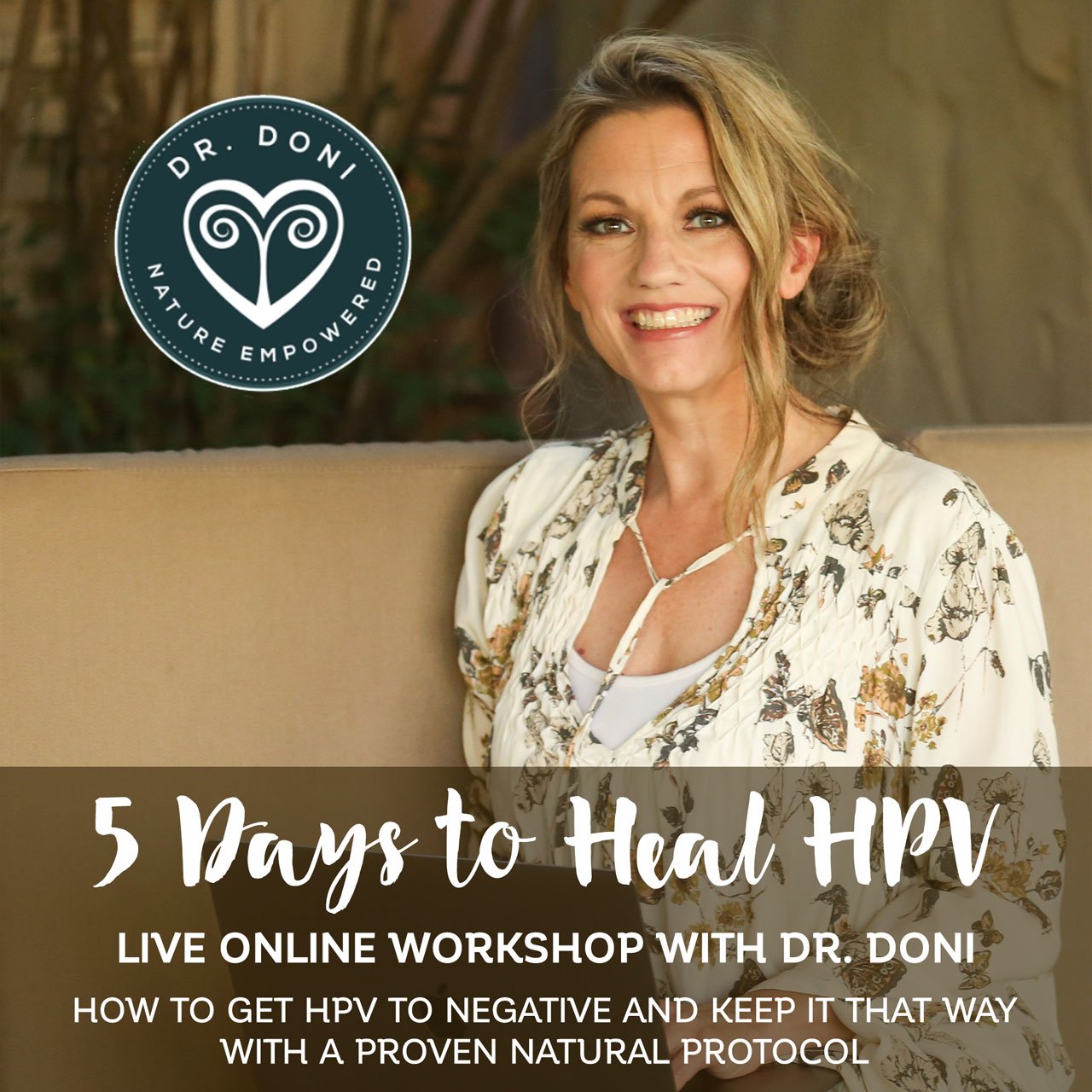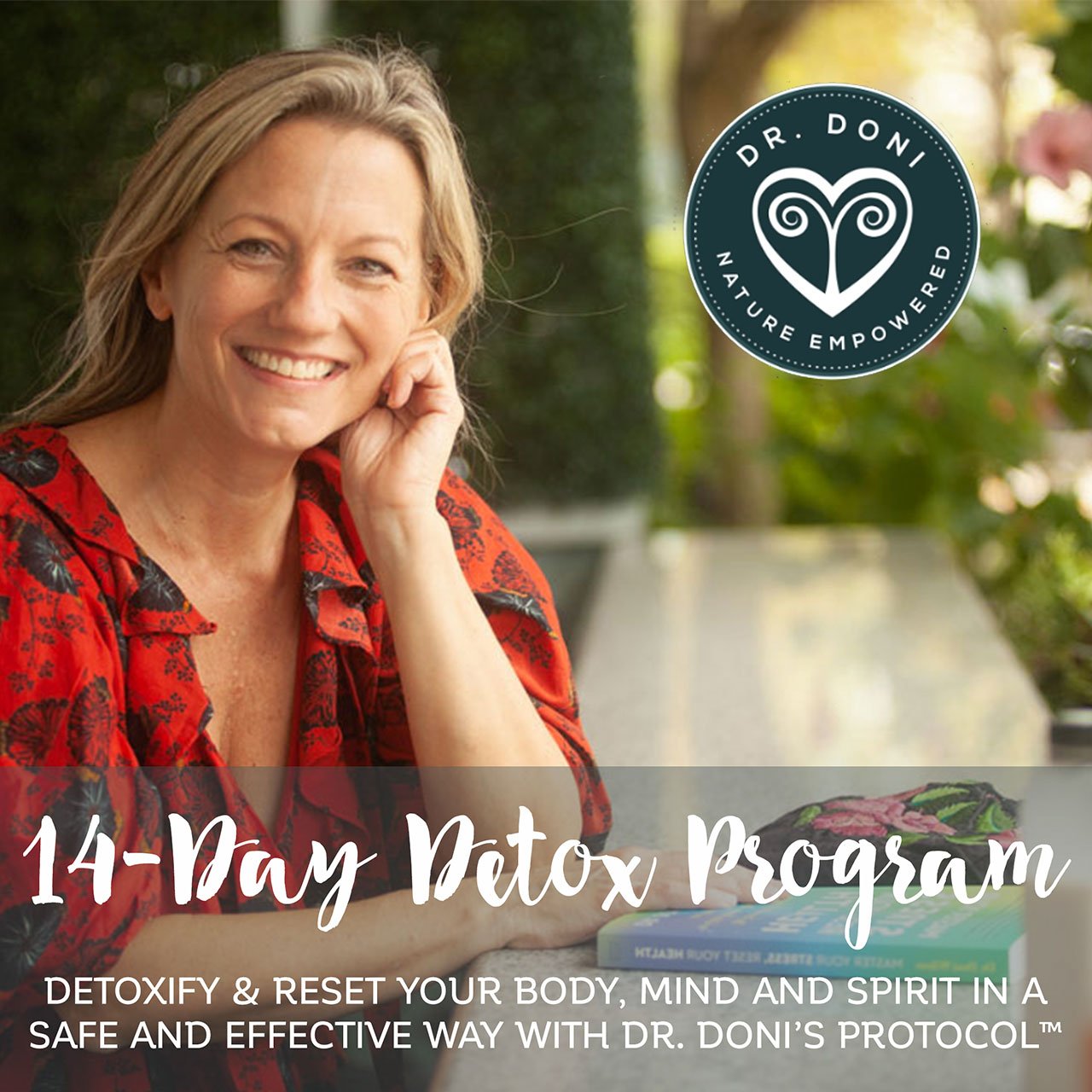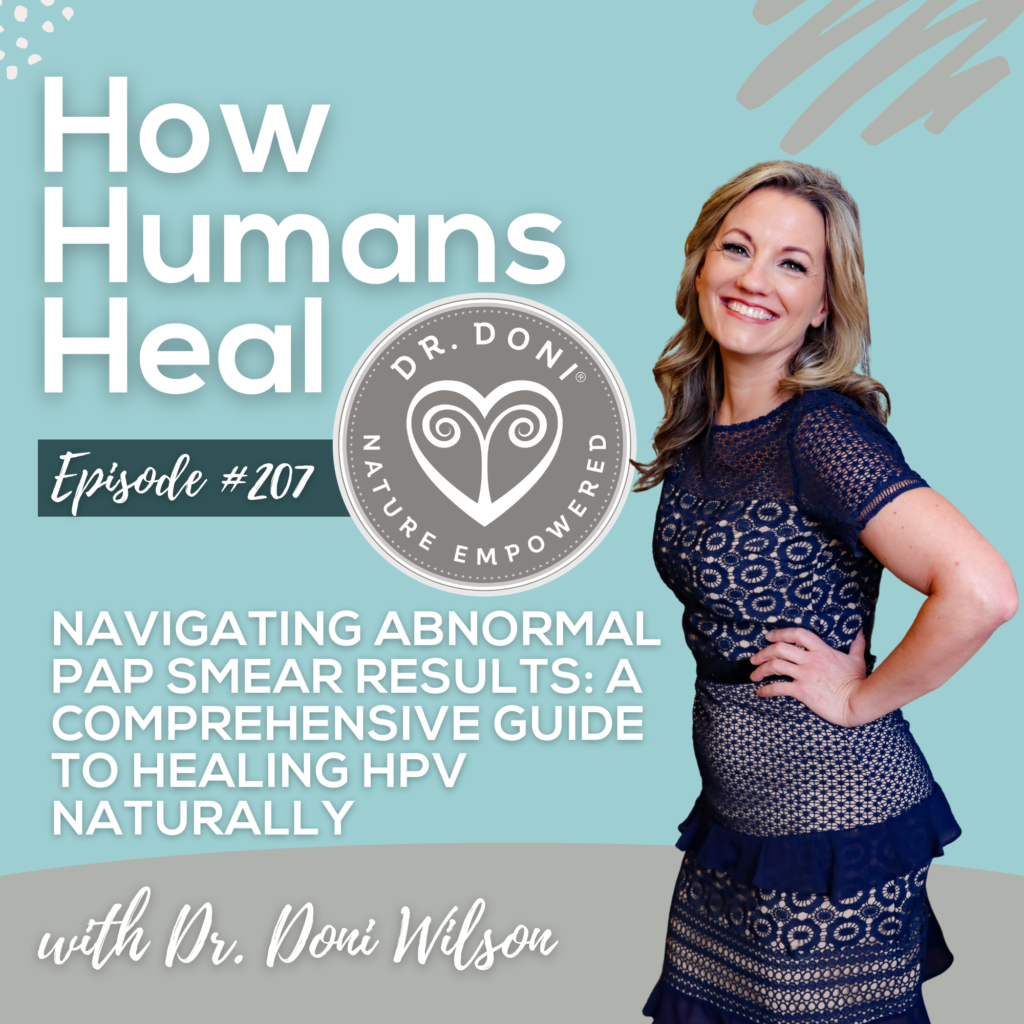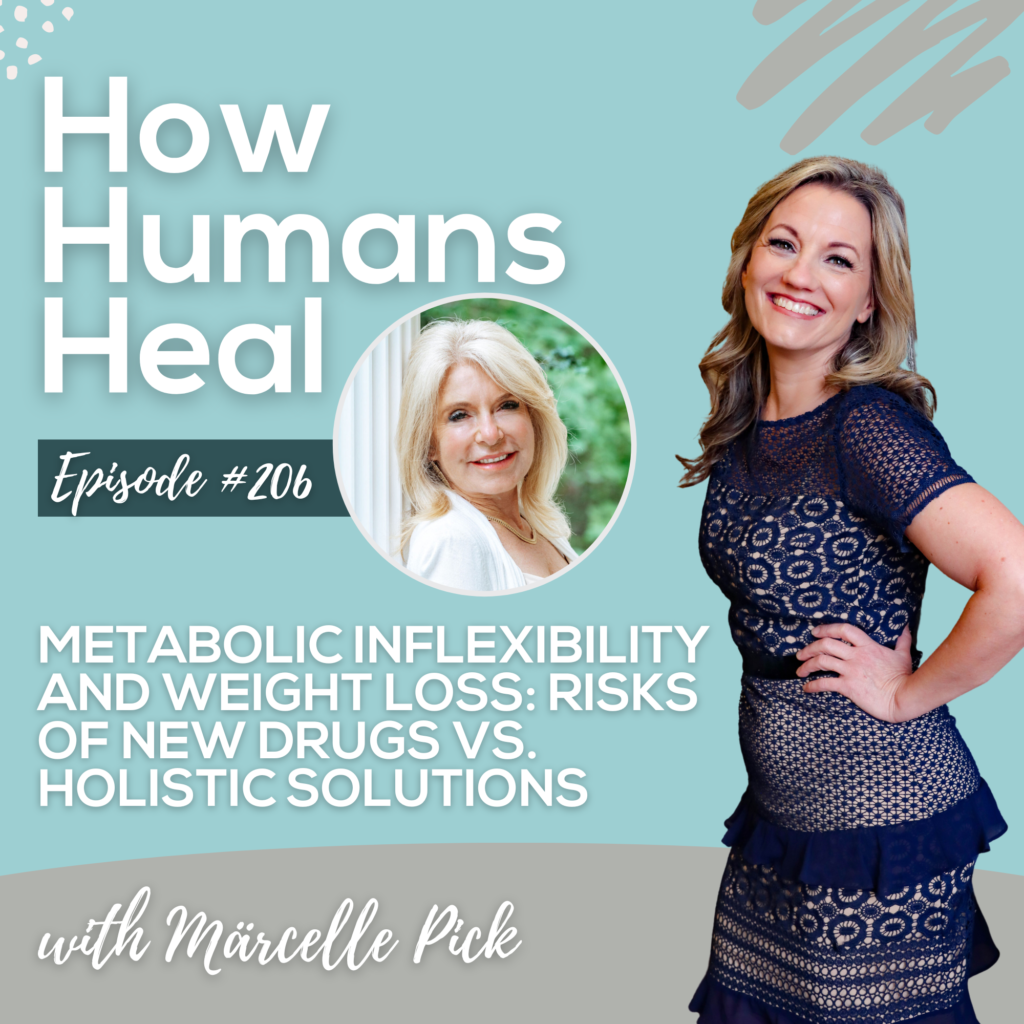
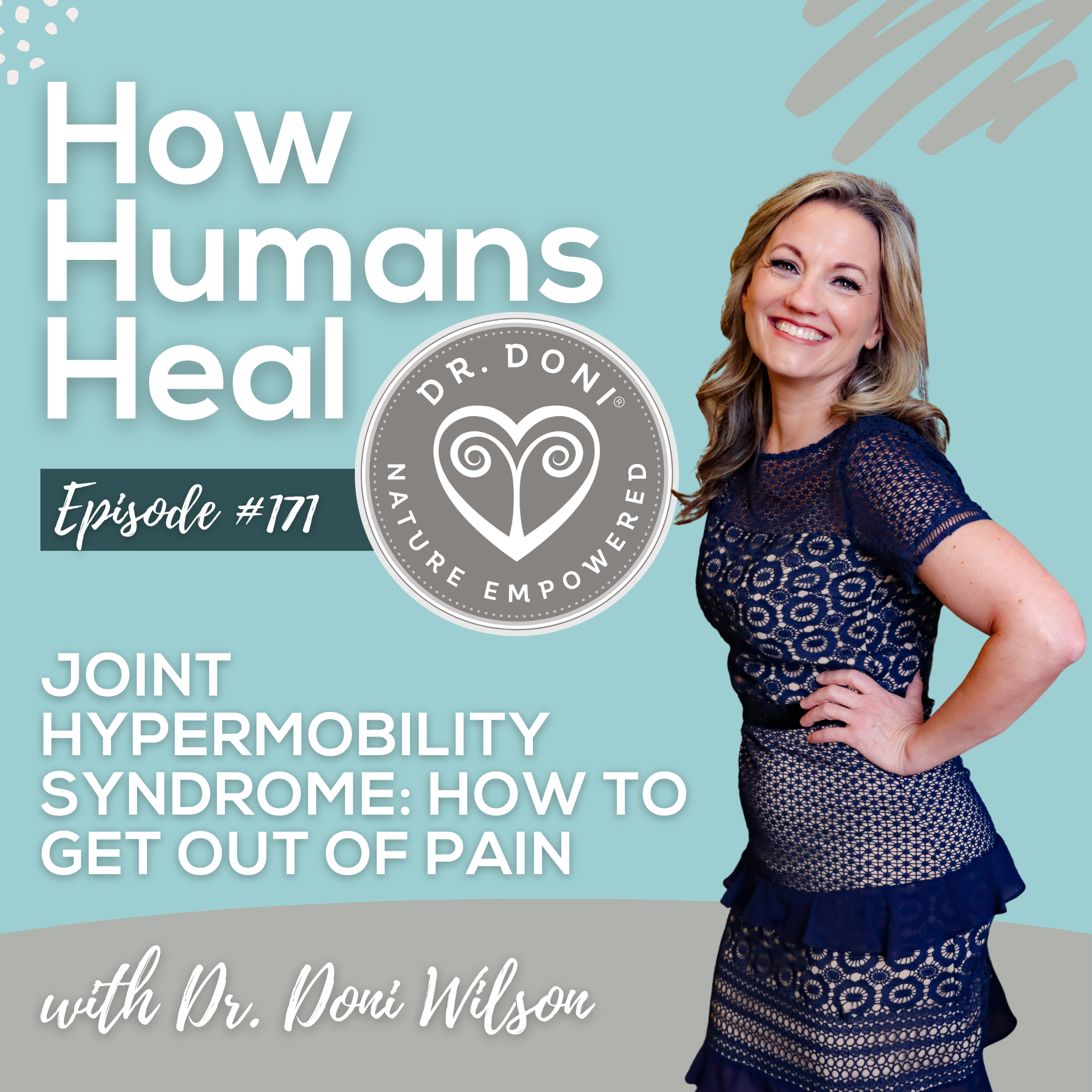
In today’s episode we’re going to be talking about joint hypermobility. This is a topic that’s important to me both clinically and personally because I was diagnosed with it a few years ago. What I find is that joint hypermobility is much more common than previously suspected, and there is so much we can do to help with the symptoms of pain, anxiety, fatigue, and more.
Joint hypermobility is sometimes referred to as joint hypermobility syndrome (JHS) or hypermobility spectrum disorder (HSD). It shows up a little bit differently in each person and is not well known by practitioners, which means that many people with hypermobility have seen numerous practitioners without receiving a diagnosis.
When they do receive a diagnosis, they are often told that “there is no cure,” which can make it seem as though there is nothing that can be done to help. That is simply incorrect. I’ll be sharing more why that is my perspective in this episode of How Humans Heal.
First, it is important to understand the various potential symptoms of hypermobility, so that you can start to understand how they are interconnected and unique to each person. That will also help us to understand why the approach needs to be individualized as well.
Mainly I want listeners/readers to know that I’m here as proof that it is possible to feel good, to be out of pain, and to thrive even when you tend toward joint hypermobility.
What Is Joint Hypermobility?
Joint hypermobility is considered a connective tissue disorder. Connective tissue involves our skin, joints, ligaments, tendons, and fascia. Hypermobility syndromes are associated with joint instability and chronic pain. If you or someone you know has been experiencing joint pain and/or muscle pain for long periods of time, this is something to consider and to talk with your practitioners about, especially those who are experts in hypermobility, so they can help guide you.
Although it has been improving in recent years, still there is very low awareness for joint hypermobility amongst practitioners. I believe that is for two reasons: 1. it’s a relatively newly identified condition. It was first described in 1967; 2. It’s considered to be a rare condition, otherwise known as a “zebra”in medicine, meaning that if someone comes in with joint pain, practitioners are more likely to think of the most common causes for joint pain before thinking of hypermobility syndrome. Research indicates that about 3% of people have joint hypermobility, but I actually think it’s higher than that and is more common than we realize.
Now, joint hypermobility may or may not be part of another diagnosis called Ehlers-Danlos Syndrome (EDS) which includes joint hypermobility, with unstable joints that dislocate easily, as well as stretchy skin, easy bruising, wounds that are slow to heal and leave wide scars, hernias and organ prolapse. There are thirteen different types of Ehlers-Danlos syndrome, some of which involve the blood vessels and digestion. To be diagnosed with EDS requires a genetic analysis to identify collagen-related gene variations.
The important thing is, if you feel joint pain or discomfort, you should start taking action now, regardless of it being hypermobility syndrome or Ehlers-Danlos Syndrome. You have to start taking steps to protect yourself and prevent it from causing further health issues.
To me the awful thing is that so many people who are diagnosed with joint hypermobility or with hypermobile Ehlers-Danlos syndrome are told it’s a genetic condition and that there’s nothing they can do, or that all that can be done is manage the pain.
To me, that is unacceptable. As a naturopathic doctor, and as someone with hypermobile Ehlers-Danlos Syndrome, I can tell you there are so many things that help me feel better, and that help me prevent symptoms and health issues associated with hypermobility. There’s so much you can do about it. I’m not saying that there’s a cure, but by understanding it and by being proactive, you can get yourself out of pain and prevent health issues associated with hypermobility.
How to Know if You Have Joint Hypermobility
Our joints and a lot of other parts of our body are made of collagen. Collagen is so important for joints, bones, ligaments, tendons, blood vessels, intestines, and more. We all make collagen slightly differently. If the way your body makes collagen makes it a little more stretchy, then you may have very flexible collagen and hypermobile joints. But remember, it’s a spectrum so not everybody with hypermobile joints can do extreme movements.
The best way to identify if you have joint hypermobility is to do a Beighton score test, which is a nine-point scale related to range of motion of joints in the body. The higher you score, the more flexible your joints are.
The Beighton test starts with evaluating if you can touch the floor with your hands with your legs straight; this gets you one point. Next is evaluating if you can hyperextend your elbows. If your elbows can extend beyond making your arm look straight, then you get one point for each elbow.
Same thing with your knees, so when you stand if your knees bow backwards, that’s hyper mobility of the knees, and that’s one point on each knee. Then there’s the fingers – a classic is to measure if your thumb can reach all the way to your forearm and another is if you’re little finger can point back more than 90 degrees from your hand, these are one point each.
And there are other signs too. If you notice other joints that can move more than other people’s or they move out of position easily (or dislocate), that’s also a sign that you may have joint hypermobility.
What Are the Symptoms Related to Joint Hypermobility?
Anxiety: There are other symptoms that can be related to joint hypermobility like fatigue, anxiety and even depression. Anxiety is highly correlated with hypermobility, research shows that 70% of people with hypermobility have anxiety, and people with anxiety are likely to have joint hypermobility as well.
Neurodivergence: Hypermobility is also correlated with depression and what’s called neurodivergence. Neurodivergence is associated with differences in social preferences, ways of learning, ways of communicating, and ways of perceiving our environment. It is often associated with autism, ADHD, and Tourette’s syndrome. Neurodivergent individuals may be more sensitive to our environment emotionally, chemically, and physically. The nervous system is more sensitive and perceptive, and that can relate to being in chronic pain.
Chronic pain: The reason for pain is caused by joints being slightly out of position, triggering muscle spasms and fascial restrictions. With hypermobility, it is harder to identify where our body parts should be in space because the joint range of motion is greater. Our nervous system also has a different perception because our joints are more flexible and it’s not so clear when motion should stop, making it less likely for our joints to automatically or naturally be in an optimal position. We have less of an internal guidance system.
Luckily it is possible to learn proprioception (where your body parts are in space), and by practicing body position and posture, we can prevent joint dislocations. For someone who has collagen that’s not so stretchy, this is easier because their joints are not allowing for further movement. If you have hypermobility, your joints will not tell you where to stop and so we have to train ourselves to know where our body is healthiest in space in order to decrease our pain and other symptoms. Muscle strength can also help keep our joints in place.
Bruising & Palpitations: Now, with joint hypermobility, and especially with Ehlers-Danlos Syndrome, you could have symptoms of easier bruising, palpitations, and/or a heart murmur, such as mitral valve prolapse (which is when the heart valves do not close properly between each beat, allowing blood to flow backwards).
Digestive Issues: You may also experience issues with the digestive tract, like constipation or diarrhea, and it may be considered IBS or irritable bowel syndrome. You may be diagnosed with IBD, which is inflammatory bowel disease such as Crohn’s disease or other forms of colitis. Hypermobility also makes it more likely that you will have Celiac disease or gluten sensitivity.
Dizziness: Joint hypermobility and Ehlers-Danlos syndrome can also be associated with dysautonomia. Dysautonomia is a disorder of autonomic nervous system function. The autonomic nervous system is in charge of involuntary functions, such as breathing and our heartbeat. It also has to do with our response to stress. Dysautonomia involves an imbalance in the sympathetic (fight or flight) and parasympathetic (rest and digest) parts of the autonomic nervous system. It can cause dizziness, fatigue, and weakness, especially when under stress.
It can also be related to POTS, or postural orthostatic tachycardia syndrome, which is a condition in which a reduced volume of blood returns to the heart and brain after standing up quickly. When you have hypermobility, you have very flexible collagen, and this makes it harder for your blood vessels to get the blood to your brain, so you feel dizzy for a few seconds until your body can catch up by increasing your heart rate. It can make you feel like you are going to faint, or actually cause you to faint.
Symptoms from Stress: Also, stress makes all these symptoms harder to manage. If you’ve been under a lot of stress, maybe going through a loss or stress at work, or stress in your relationship, or trauma of some sort, then your autonomic nervous system will be affected and not work smoothly. The sympathetic nervous system carries signals that put your body’s systems on alert, while your parasympathetic carries signals that relax those systems.
We need a balance of the two. We need our bodies to be able to do a stress response and protect us from danger, but we also need our bodies to be able to turn off the stress response and go back to calm. When we’re under constant stress, our bodies have a harder time flexing between the sympathetic and parasympathetic nervous systems. That’s when the autonomic nervous system starts having a harder time, and we start becoming more susceptible to infections (HPV, EBV, etc) and toxins, especially for those of us with hypermobility.
Mast Cell Activation: Another issue related to joint hypermobility and Ehlers-Danlos syndrome is mast cell activation syndrome or MCAS. Mast cells are present throughout our bodies and secrete chemicals during allergic reactions, histamine in particular. Symptoms include episodes of abdominal pain, cramping, diarrhea, flushing, itching, wheezing, coughing, lightheadedness, rapid pulse and low blood pressure.
Mast cell activation (and histamine) can also be related to headaches, like migraines, as well as neuropathy, symptoms of vulvovaginal pain, vaginitis and urinary/bladder pain. Autoimmunity, like rheumatoid arthritis and psoriasis, and other inflammatory conditions, like ankylosing spondylitis and SAPHO, are also related.
MTHFR and Methylation Issues: A recent study associated hypermobility with MTHFR gene variations. MTHFR is the gene that manages the conversion of folic acid into folate, and folate is the active form of vitamin B9. Of course we all need B9 along with all the other B vitamins to help us in so many processes, including having healthy connective tissue.
If we don’t have enough folate, and if we don’t have healthy methylation, this is going to affect the way our body creates collagen. If we know that MTHFR is associated with hypermobility, and we know that not having enough folate and effective methylation affects your connective tissue, then we can do something about that. We can make sure you have adequate folate, and we can make sure you have effective methylation, in order to help protect your connective tissue and prevent pain and other health issues.
If you want to learn more about this, I encourage you to go listen to Episode #145 of my podcast: Efficient Methylation and its Impact on Our Health as well as my Free MTHFR Masterclass.
What Can We Do to Help Our Bodies if We Have Joint Hypermobility?
It is possible to help your body rebalance and correct where it needs help. To me, it’s about understanding your biochemistry, and understanding your body’s tendencies, and giving your body what it needs to heal and rebalance, which usually comes in the form of dietary changes, nutrients, supplements and herbs.
A lot of people feel stuck with their symptoms and the need for medications. With joint hypermobility, the main issues are joint and muscle pain, so one of the first treatments recommended is a pain medication, like non-steroidal anti-inflammatory drugs (NSAIDs). While offering temporary relief, they have a lot of side effects and can’t be taken long term, plus they’re not really solving anything, in fact, they might be making things worse, so that’s not really a solution.
Neither are steroidal drugs for pain as they also have negative effects on our bodies. Additionally, medications prescribed for hypermobility symptoms, such as anti-depressants and benzodiazepines, create dependency and have withdrawal symptoms.
To me, it’s not enough to tell people with joint hypermobility that the only option is pain management. There is so much more that we can do. There are ways to manage pain by actually decreasing inflammation and using natural substances that don’t have side effects. It is also possible to start helping your body alongside the use of medications when you are working with an expert who understands the interactions and is able to guide you.
Physical therapy, massage therapy, myofascial therapy, acupuncture and exercises for posture and strength (such as Pilates) can help reduce the symptoms. It is important to make sure the practitioner or trainer understands what joint hypermobility is and the special needs that your body has because when you have joint hypermobility, you are more likely to suffer from injuries.
The approach needs to be completely different. It’s not about increasing flexibility or increasing intensity too much. And It’s also NOT going to help to stop exercising all together. It IS about doing the right type of exercise, in the right amount and frequency, for your body.
For me Pilates has been extremely helpful. It helped me to learn joint position and posture, and to gain strength without causing injury. Ballroom dancing also helps with posture and strength.
Myofascial release therapy has been hugely helpful as it can release the restrictions in the connective tissue. If you want to learn more about myofascial release therapy you can watch Episode #166 of How Humans Heal: Myofascial Release Therapy – Bringing Your Body Back to Alignment. Also in Episode #170 you can learn about how to get rid of joint and muscle pain using natural remedies.
Acupuncture and especially acupuncture that’s using electrical stimulation can also help address the trigger points and motor points in the muscles, so it is a great option too.
Paying attention to your body, your posture, and your strength every day is a must if you have joint hypermobility. You can’t just get a massage once a year or go to physical therapy only if you get injured. You have to have a weekly plan to help relieve the symptoms and prevent injuries. If you don’t keep up with that routine of managing your body and your joints, that’s when you are more likely to find yourself in pain and at a greater risk of injuries.
Dietary changes to reduce inflammation, testing for food sensitivities, healing leaky gut, addressing the gut biome are all things that can help. If there is leaky gut and imbalanced gut biome, you have a source of inflammation from within your gut, and that’s causing inflammation through your whole body which is going to increase your likelihood of pain.
Our biome is so important. It’s not just about having a bunch of bacteria or probiotics. It’s about having the right balance and how these bacteria communicate with our immune system and our nervous system. If you would like to learn more about how to balance your microbiome you can watch Episode #169 of my podcast: Getting Your Microbiome Back on Track.
It is also essential for anyone who has hypermobility to measure your cortisol and adrenaline levels. Hypermobility makes it more likely that your nervous system and adrenal gland function are disrupted by stress. It’s more likely that you’re going to have neurotransmitter imbalances, and either too high or too low cortisol and adrenaline, or what I call the stress types (the five most common disruptions of cortisol and adrenaline).
That’s what I wrote about in the Master Your Stress Reset Your Health book. If you want to find out if your cortisol and adrenaline are out of balance, you can order my home test kit here. You can also take the Stress Type Quiz online and sign up for my Stress Warrior Program to guide you to optimize your cortisol and adrenaline (adrenal health) here.
We also need to do specific blood work so we can understand exactly how hypermobility is affecting you and if you have nutrient deficiencies. If you have hypermobility and inflammation and nutrient deficiencies, it could snowball into various health issues. This is why we need to look at the big picture, see the interconnections, and then guide your body through the steps to heal and prevent more health issues.
The best treatments for hypermobility are from what I would consider a naturopathic approach. It has to do with giving your body what it needs to heal in terms of food, nutrients, plants, herbs and other natural approaches. We need to make sure you are consuming adequate amounts of protein – learn more about that here. We can support the body to heal itself by working on the root causes of problems and solving them.
If you want to work on your gut health and microbiome you may want to sign up for my Heal Leaky Gut Program where I teach you how to heal leaky gut with my proven protocol. Keep in mind that 50% of people with leaky gut, have zero digestive symptoms, so the only way to know for sure is to do the food sensitivity panel I recommend.
If you’re interested in learning more about my approach to healing HPV you can find my new HPV Recovery Guide here. If you are tired of this virus and are really committed to erasing it from your life forever, you can sign up for my Say Goodbye to HPV 12-Week Program here.
You can also subscribe to my newsletter where you’ll receive a newsletter from me every Thursday with the latest episode and additional resources and tools for your success with achieving optimal health.
For the most comprehensive support, even with the most difficult health issues (physical or mental), it is best to meet with me one-on-one, which is available to you no matter where you are in the world (via phone or zoom). You can set up a one-on-one appointment with me here.
We’re here to help you!

Connect with Dr. Doni:
- Facebook https://facebook.com/drdoniwilson
- Instagram https://instagram.com/drdoniwilson
- YouTube https://youtube.com/DoniWilsonND
- Newsletter: https://doctordoni.com/www (Weekly Wellness Wisdom)
- Podcast: https://doctordoni.com/podcast (How Humans Heal)
More Resources from Dr. Doni:
- Stress Type Quiz: Assess your adrenal function
https://doctordoni.com/quiz - Dr. Doni’s Book: Master Your Stress, Reset Your Health
https://doctordoni.com/book - Dr. Doni’s Facebook Group: Stress Warrior Stress Resiliency
https://facebook.com/groups/stresswarrior - HPV Recovery Guide (FREE)
https://doctordoni.com/ddpp/hpv-guide/ - FREE Masterclasses with Dr. Doni
https://doctordoni.com/masterclasses - FREE Guides from Dr. Doni
https://doctordoni.com/guides
Personalized Solutions:
- 14-Day Detox Program: You can start this transformation program anytime
https://doctordoni.com/detox-program - Say Goodbye to HPV (12-week Program): Begin the journey to freedom from HPV today!
https://doctordoni.com/hpv-12-week - If you’d like to meet with Dr. Doni one-on-one for your health, request a Health Breakthrough Session: https://doctordoni.com/breakthrough
Disclaimer: This specific article and all other Content, Products, and Services of this Website are NOT intended as, and must not be understood or construed as, medical care or advice, naturopathic medical care or advice, the practice of medicine, or the practice of counseling care, nor can it be understood or construed as providing any form of medical diagnosis, treatment, cure, or prevention of any disease.
References:
- Diagnosis and Management of Hypermobility Spectrum Disorders in Primary Care. Karina Atwell, William Michael, Jared Dubey, Sarah James, Andrea Martonffy, Scott Anderson, Nathan Rudin and Sarina Schrager: https://www.jabfm.org/content/34/4/838.
- The Journal of the American Board of Family Medicine July 2021, 34 (4) 838-848; doi: https://doi.org/10.3122/jabfm.2021.04.200374.
- Csecs JLL, Iodice V, Rae CL, Brooke A, Simmons R, Quadt L, Savage GK, Dowell NG, Prowse F, Themelis K, Mathias CJ, Critchley HD, Eccles JA. Joint Hypermobility Links Neurodivergence to Dysautonomia and Pain. Front Psychiatry. 2022 Feb 2;12:786916. doi: 10.3389/fpsyt.2021.786916. PMID: 35185636; PMCID: PMC8847158:https://www.ncbi.nlm.nih.gov/pmc/articles/PMC8847158/.
- Courseault J, Kingry C, Morrison V, Edstrom C, Morrell K, Jaubert L, Elia V, Bix G. Folate-dependent hypermobility syndrome: A proposed mechanism and diagnosis. Heliyon. 2023 Apr 9;9(4):e15387. doi: 10.1016/j.heliyon.2023.e15387. Erratum in: Heliyon. 2023 May 16;9(5):e16356. PMID: 37095957; PMCID: PMC10122021: https://www.ncbi.nlm.nih.gov/pmc/articles/PMC10122021/.
- Monaco A, Choi D, Uzun S, Maitland A, Riley B. Association of mast-cell-related conditions with hypermobile syndromes: a review of the literature. Immunol Res. 2022 Aug;70(4):419-431. doi: 10.1007/s12026-022-09280-1. Epub 2022 Apr 21. PMID: 35449490; PMCID: PMC9022617: https://www.ncbi.nlm.nih.gov/pmc/articles/PMC9022617/.
Share this Post:
Dr. Doni Wilson
14 Day Detox Program
Take the Stress Type Quiz
Dr. Doni Social Media
Popular Posts

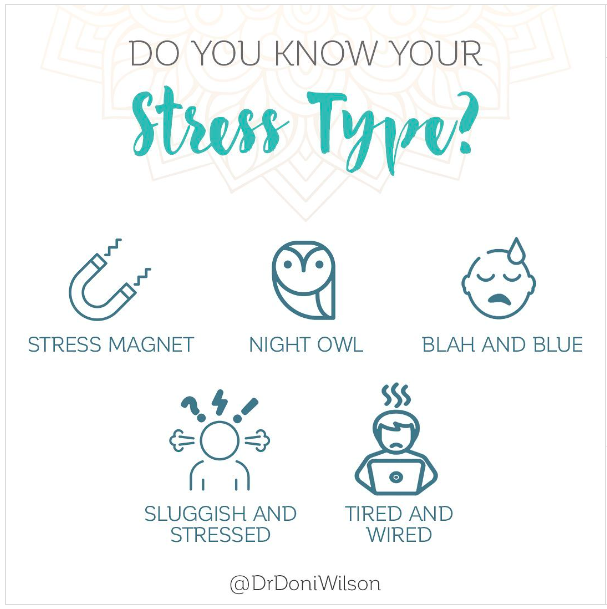
The 5 Burnout Types

Healing HPV Holistically: Dr. Doni on the Inspire Health by Jen Podcast
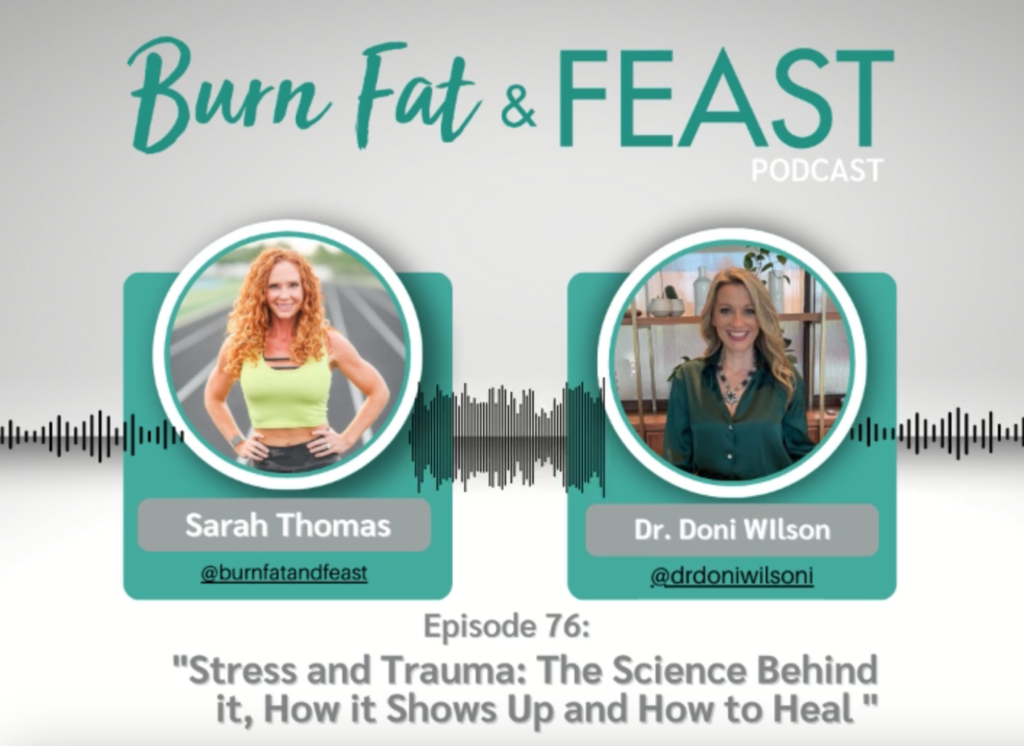
Recent Podcasts
Signup to receive our weekly newsletter with all the latest news, podcasts and special offers
New Book - Order Today!
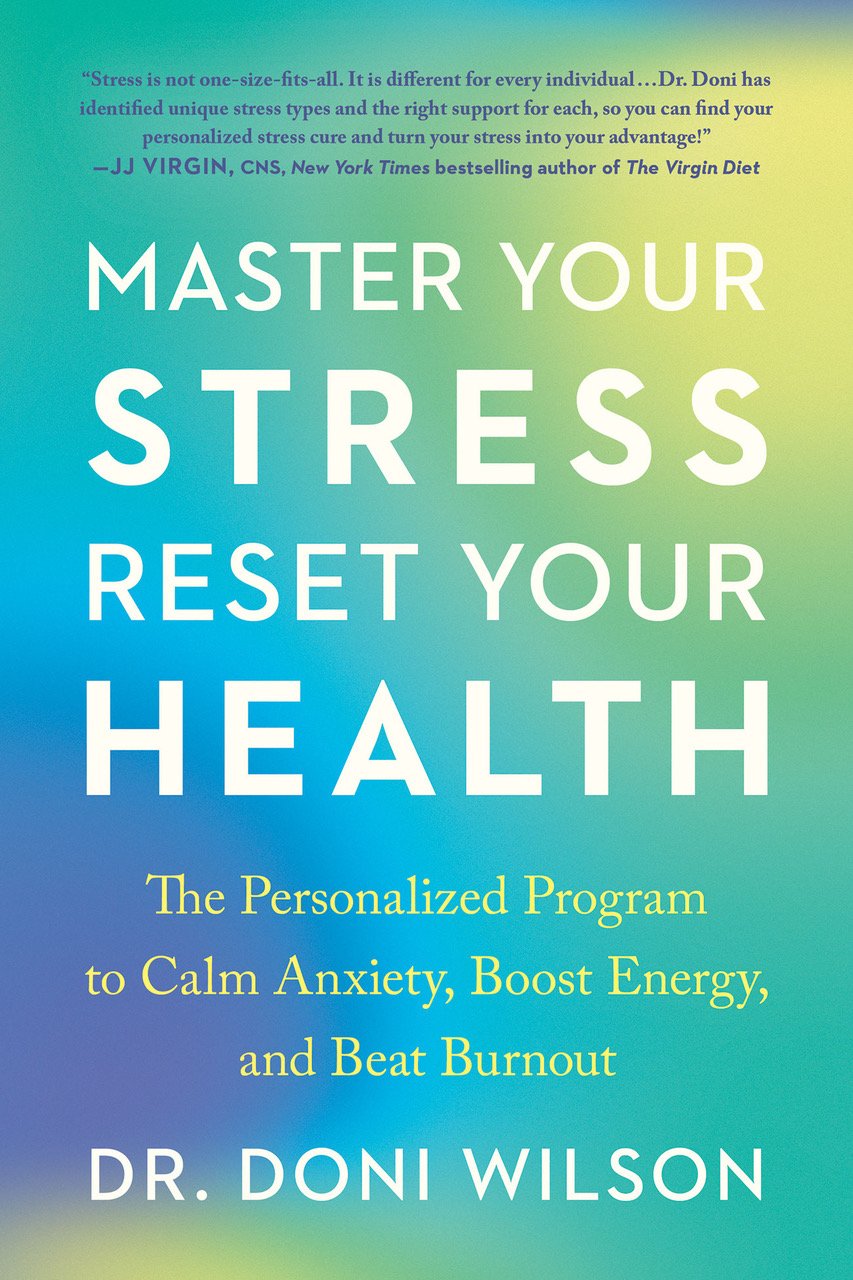
SIMPLE PRACTICES for SHIFTING FROM YOUR STATE of STRESS to YOUR FLOW and FREEDOM
MASTER YOUR STRESS
RESET YOUR HEALTH
Order Now! Related Posts

What is making you susceptible to HPV?
I have been working with women who had abnormal cells on their cervix and/or vaginally, caused by HPV for over 20 years now. And while

The 5 Burnout Types
Did you know there are 5 burnout types? They are based on your Stress Type®, which is how your adrenal function has been affected by

Healing HPV Holistically: Dr. Doni on the Inspire Health by Jen Podcast
Dr. Doni was interviewed by Jen Ciszewski on the Inspire Health by Jen Podcast, talking about how to heal away HPV from your body for good.

Stress and Trauma: The Science Behind It, How It Shows Up and How to Heal: Dr. Doni on The Burn Fat and FEAST Podcast
Dr. Doni was interviewed by Sarah B. Thomas on the Burn Fat and FEAST Podcast, talking about the impact of stress and trauma on our health and what to do to recover from them.


